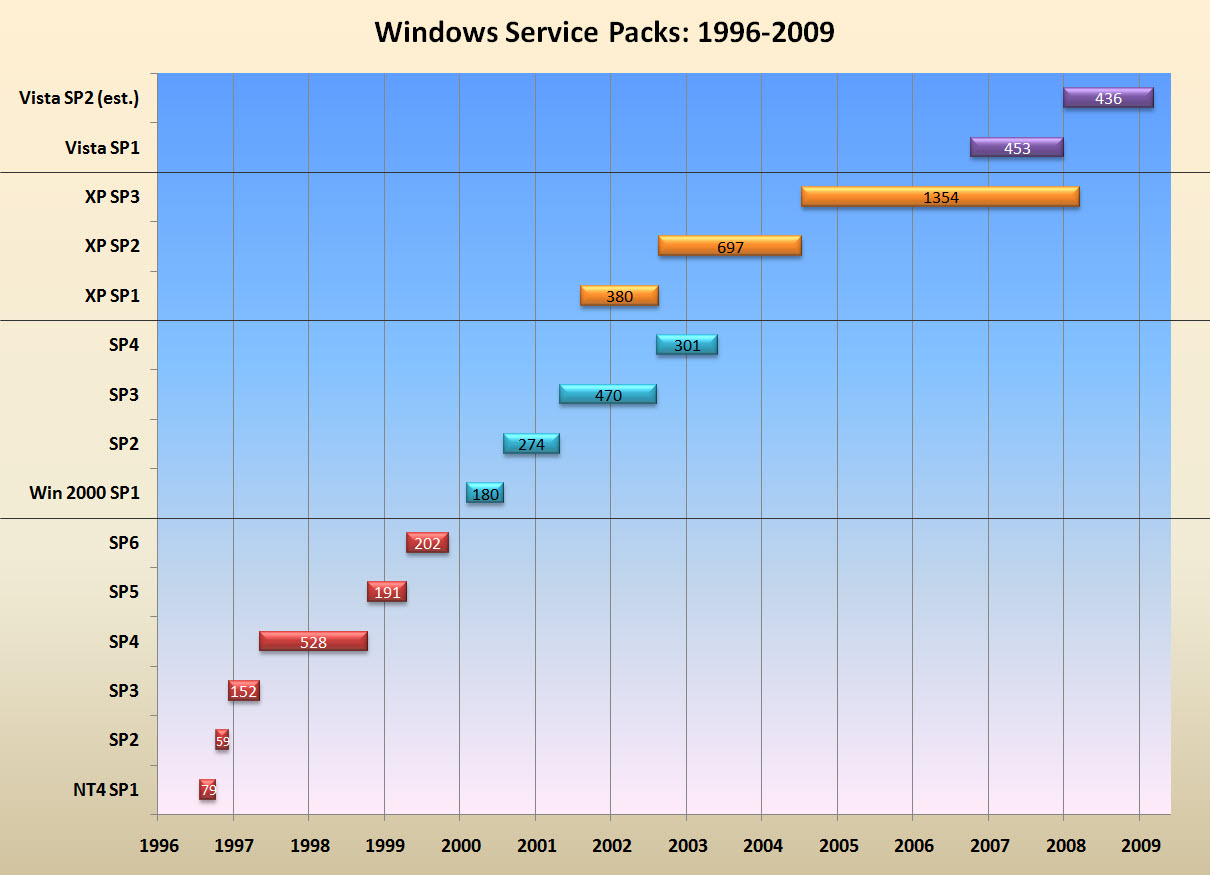With Vista SP2, Microsoft is back on track

From the other side of the world comes a report that Windows Vista Service Pack 2 will be released to manufacturing in April 2009, roughly a year 14 months after SP1. The Malaysian website TechARP has a pretty good track record with this sort of prediction, and my sources tell me that schedule sounds about right.
Meanwhile, here in the U.S.A., some people are inferring more Vista doom and gloom from this schedule. My buddy Dwight Silverman at the Houston Chronicle says “SP2 is being rushed out the door” to keep up Vista’s momentum. Eweek’s Channel Insider calls SP2 a “last-ditch attempt to drum up sales for [the] beleaguered [Vista] operating system.” The Register says "Microsoft seems to be in a hurry with this release.”
They all need to dust off their Windows history books to see that the reality is exactly the opposite. If Vista SP2 does make its official appearance in April, it will mark a return to normal development and release cycles for Microsoft, which lost its way badly with Windows XP.
I’ve got the proof, in easy-to-read chart format. Here’s a timeline of every Windows service pack Microsoft has delivered since the release of Windows NT 4.0 in July 1996. Each color-coded bar represents the number of days between each service pack and its predecessor (RTM, in the case of SP1 releases). See any patterns?
As measured by service pack releases, the XP era was a distinct anomaly for Microsoft. Over the past 12 years, Microsoft has delivered 14 Windows service packs. The gap between SP1 and SP2 was a record 697 days, nearly two full years. But that pales in comparison to the gap between SP2 and SP3, which was nearly four years. If we throw out SP3 and also disregard NT4 SP2, which appeared a mere 59 days after its predecessor, we discover that the average gap between service-pack releases is around 300 days, or just under a year apart. If Vista SP2 arrives in mid-April 2009, it will be 355 436 days since its predecessor, or very close to in line with the historical averages.
In fact, the chart gets even more interesting if you include major updates delivered in formats other than service packs. The expanded chart below paints an interesting picture:
Sometimes these not-quite-a-service-pack updates take the form of “update rollups.” The most noteworthy recent example was Update Rollup 1 for Windows XP, which was released on October 15, 2003, about midway between XP SP1 and SP2. It wasn’t a service pack, but it did offer an easy way to install a year’s worth of security patches on Windows XP without having to download them via Windows Update. (And no, there was no Update Rollup 2 for Windows XP, although Microsoft has used that term for several cumulative updates to the Media Center and Internet Explorer components of XP and Vista.)
Update rollups are also the preferred way to end a product’s lifecycle. After Windows NT4 SP6 and Windows 2000 SP4, Microsoft released update rollups containing 18 to 24 months worth of security updates and patches for each OS. It was the last big update release for both operating systems. When I compare that pattern to that of XP SP3, I think it’s a pretty safe bet that SP3 is the last big update we will ever see for XP.
Beginning with Windows Vista, Microsoft is using Windows Update to deliver reliability, compatibility, and performance fixes in addition to security patches. For Windows users, this is a new development. Windows XP users never got this type of update, but Vista users were treated to a steady stream of them:
Updates 938194 and 938979 were both released on August 7, 2007 and made major improvements in reliability, performance, and compatibility. In fact, the Microsoft Knowledge Base article for the latter update implies that it is the heart of Vista SP1 and recommends installing it “if for some reason you cannot upgrade to the full Windows Vista Service Pack 1.”
This stream of non-security updates has continued at regular intervals:
- 941649, released October 23, 2007
- 946041, February 11, 2008
- 952709, June 24, 2008
- 955302, August 11, 2008
That’s an update roughly every quarter, and is a major reason why those who actually use Vista have noted dramatic improvements even after Service Pack 1.
In addition, Microsoft has released application compatibility updates on a similar schedule:
- 929427, January 2007
- 932246, March 2007
- 935280, July 2007
- 943302, December 2007
- 947562, May 2008
- 954366, August 2008
A new Application Compatibility Update for Windows Vista is due this month.
By contrast, Microsoft released only three application compatibility updates for Windows XP, all within roughly six months of XP’s October 2001 release.
Around Windows XP Service Pack 2, Microsoft’s development and release cycle fell apart. Up until that point, customers could count on getting major update packages at least every year. After SP2, XP was basically ignored except for critical security updates, and Vista’s struggles are well documented.
But as I’ve discovered in researching this post, Microsoft seems to have hit a predictable update cycle for Windows desktop releases, with quarterly fixes delivered via Windows Update and rolled up into annual service packs. The crisis-driven development processes that defined Windows from 2003 until Vista’s release in early 2007 appear to be over, replaced by a much more disciplined management. Corporate customers in particular have every right to be skeptical, but if Microsoft can maintain this newfound commitment to shipping on schedule, it's good news for Windows customers in all markets.
